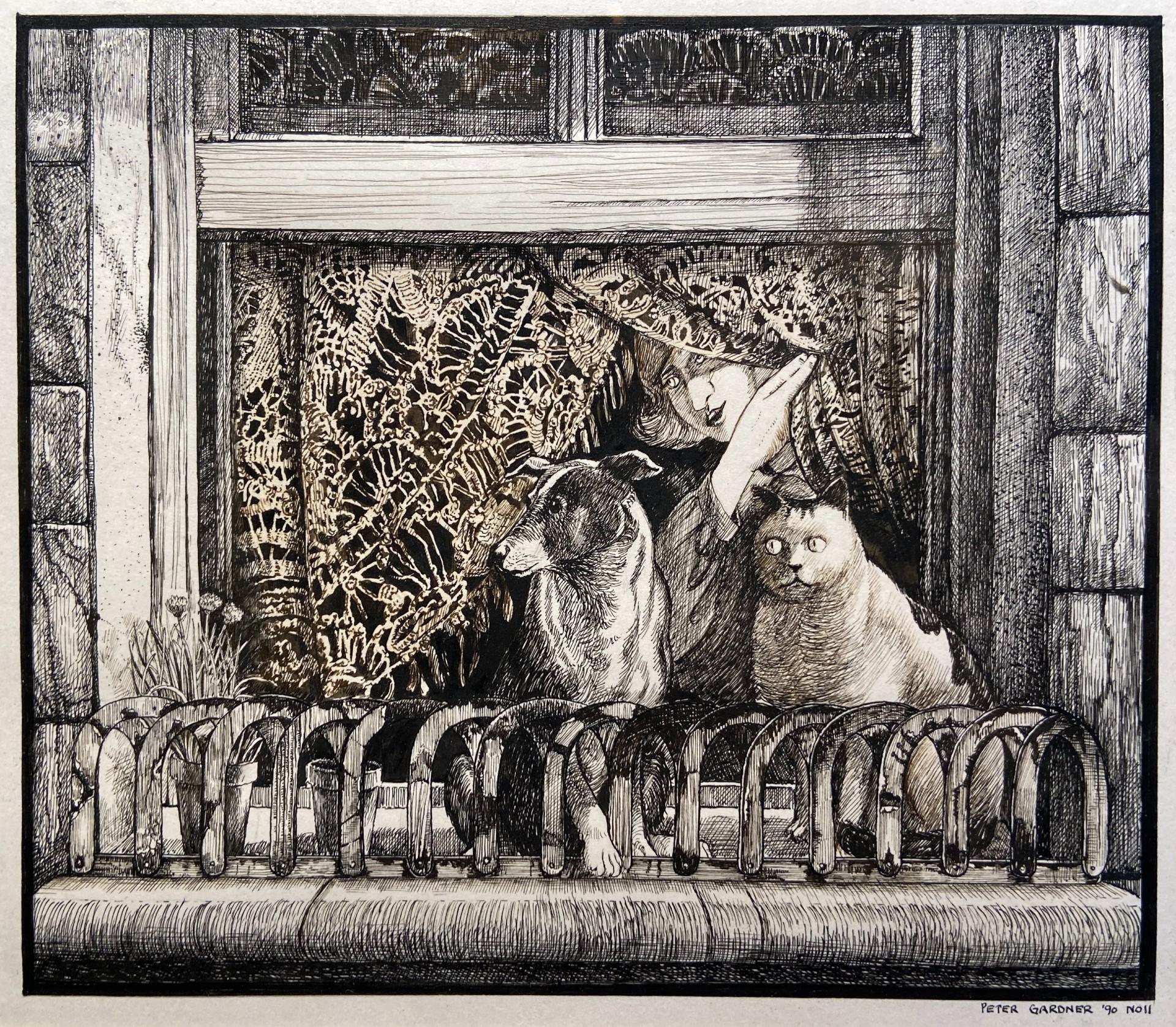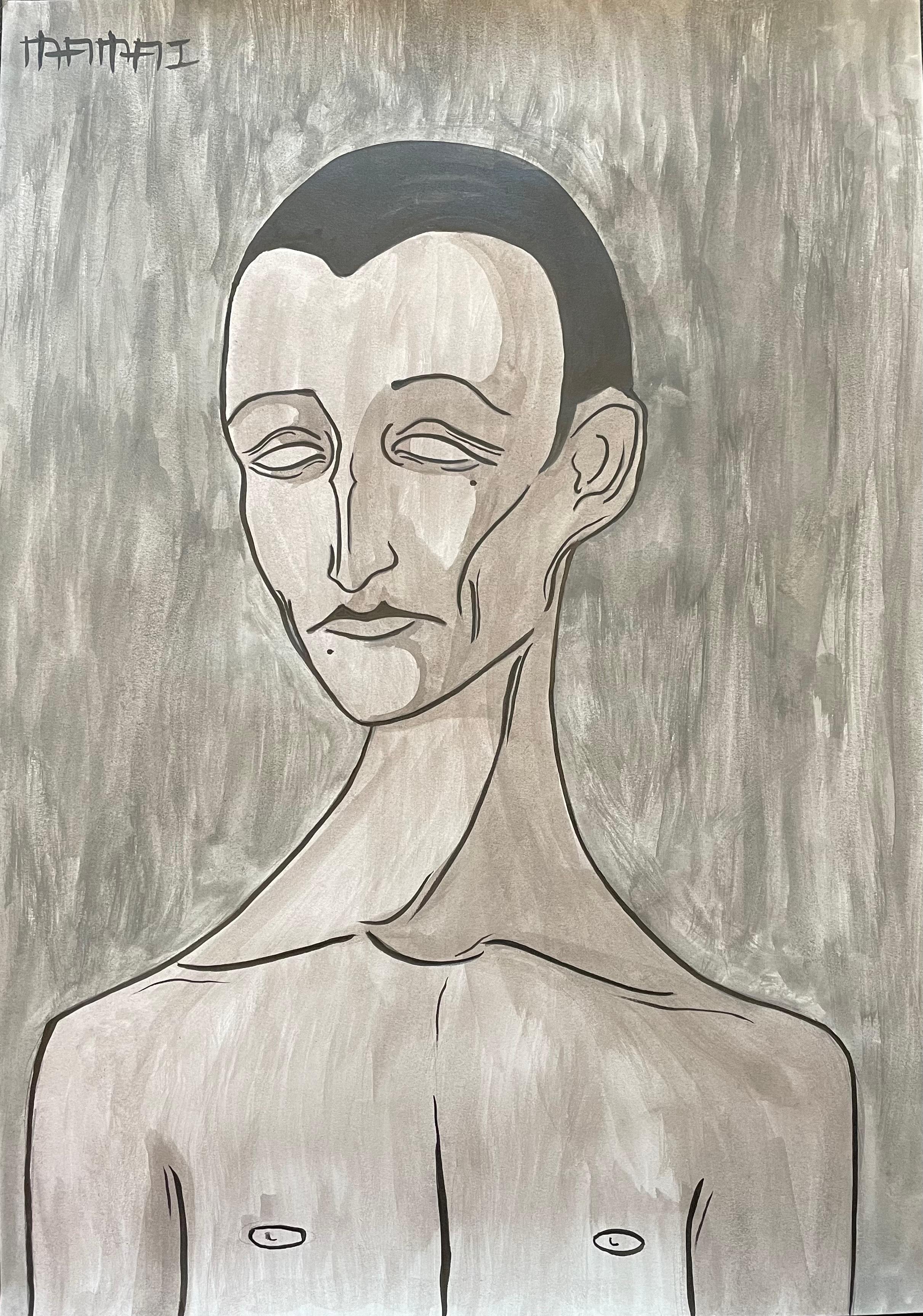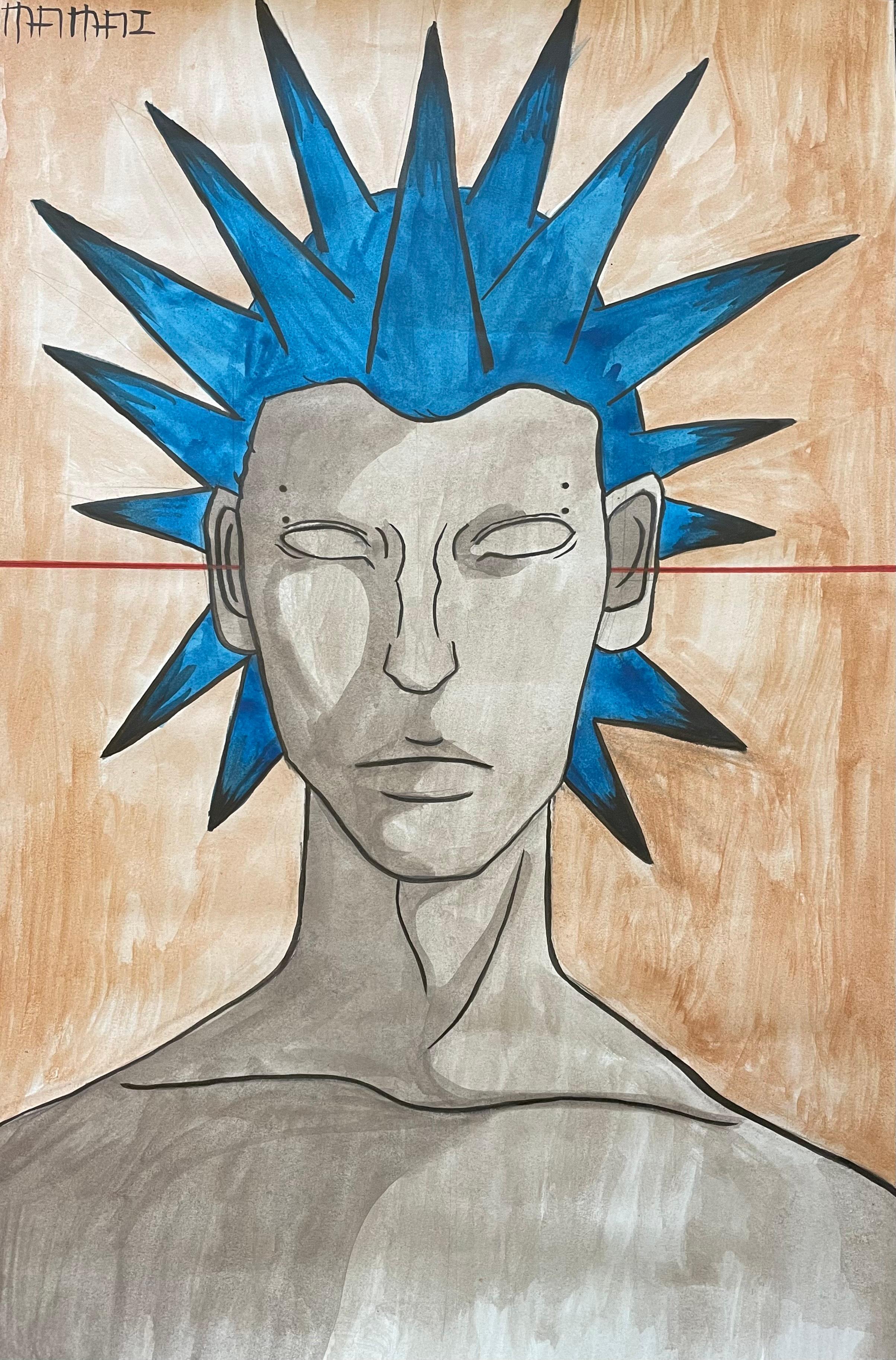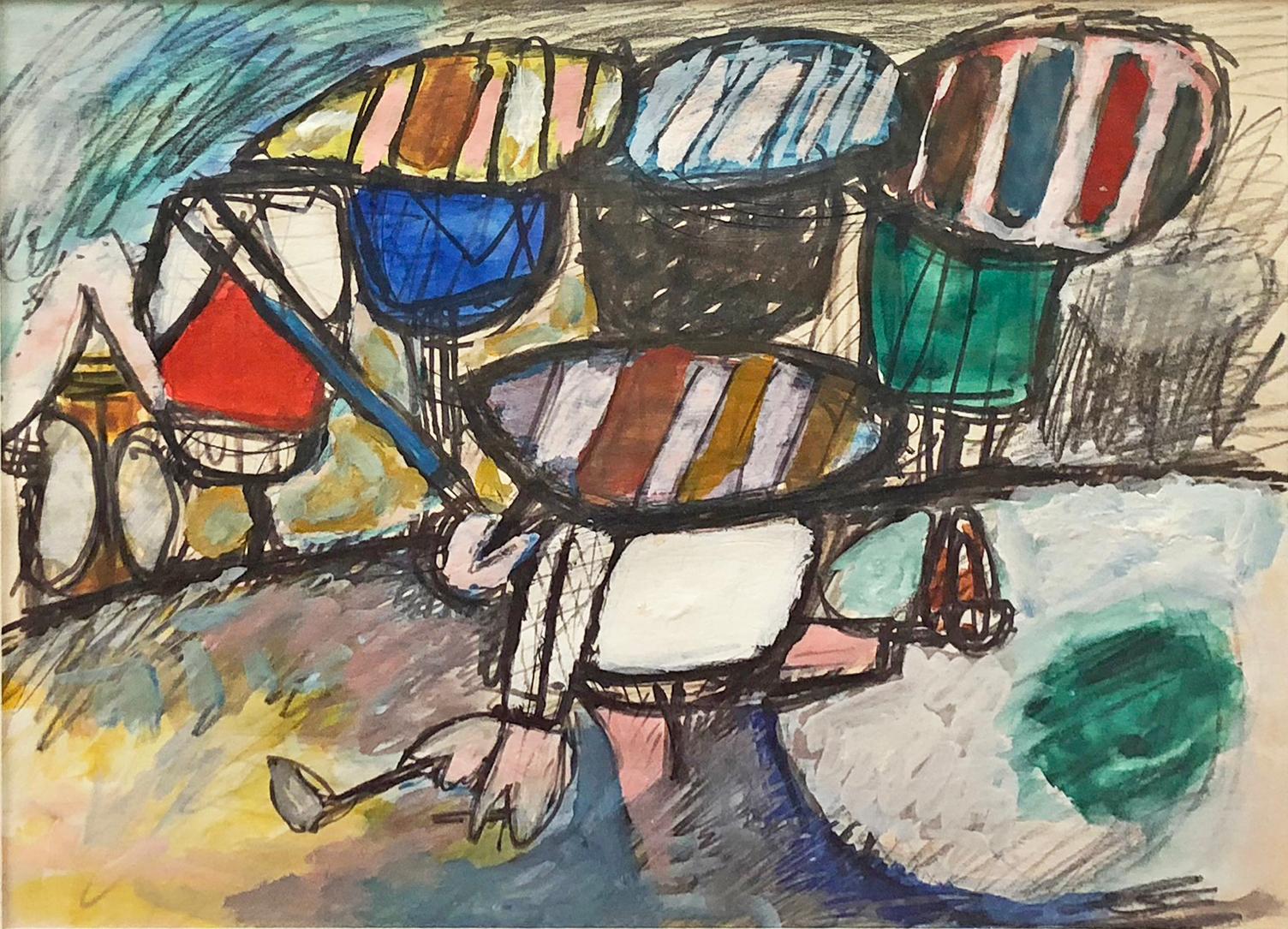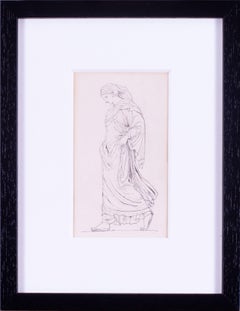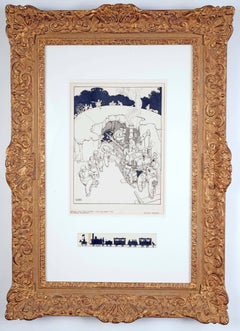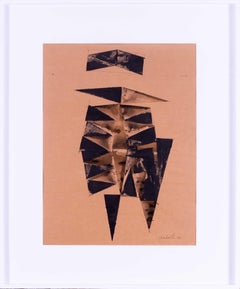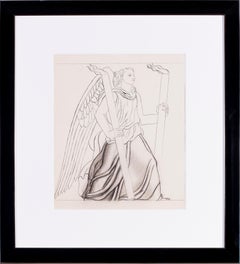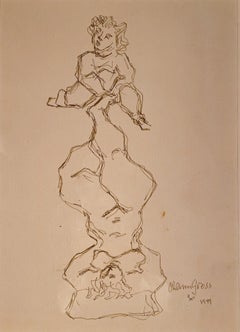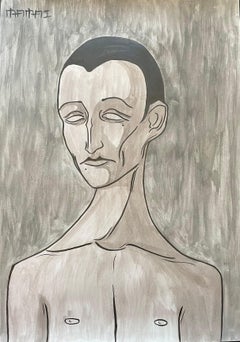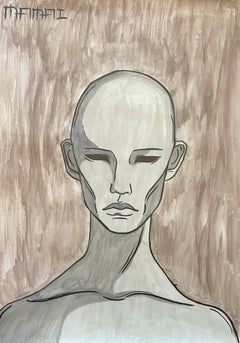Items Similar to Mid Century St. Ives artist Sven Berlin 'A lover's embrace' pen and ink on paper
Want more images or videos?
Request additional images or videos from the seller
1 of 4
Sven BerlinMid Century St. Ives artist Sven Berlin 'A lover's embrace' pen and ink on paper1995
1995
About the Item
Sven Berlin (British, 1911 - 1999)
A Lovers embrace
Pen and ink
Signed 'SVEN 95' (lower right)
11 x 7.7/8 in. (20 x 28 cm.)
Sven Berlin, born in Sydenham, London on 14th September 1911, was an English painter, draughtman and writer. He was a key player in the development of the St. Ives art movement.
Having studied at the Beckenham School of Art and after a successful career as an adagio dancer in the music-halls he moved to Cornwall with his first wife Helga in 1938 to study at the Camborne-Redruth School of Art, pre-dating the arrival of Barbara Hepworth and Ben Nicholsen to Cornwall.
As WW2 broke out, Berlin initially remained a conscientious objector. He worked in the market garden established by the art critic Adrian Stokes outside St Ives. Here he met Nicholson, Hepworth and Peter Lanyon. These artists would later establish the Modernist movement. During this time, he penned the biography for Alfred Wallis, the first profile to be written on the artist, published in 1949 and still in print today.
Berlin did eventually join the Army, taking part in the D-Day landings. Returning to St Ives after a breakdown, Berlin divorced Helga and met his second wide Juanita Fisher in 1949.
Berlin set up his new studio in ‘The Tower’ next to Porthwidden Beach, and began carving stone sculptures outside, including the Mermaid and Angel in 1948, and The Lion which was commissioned for the St. Austell Brewery.
Berlin frequently exhibited paintings, drawings, and sculptures with the St. Ives Society of Artists. In London, Berlin was a founding member of the Crypt Group along with Peter Lanyon and John Wells, also members of the St Ives artistic group. A flamboyant and outspoken personality, Berlin did not get on well with many of his peers. Following a conflict between the St. Ives Society of Artists, the Crypt Group and the Penwith Society, Berlin was ostracised from the art colony and relocated to the New Forest in 1953.
Here Berlin produced some of his most established work using animals as a source of inspiration. 1962 was a hard year for Berlin. His second wife Juanita left him for their groom Fergus Casey and the disputes which had led him to leave Cornwall inspired Berlin to write The Dark Monarch, an embittered roman à clef about the St Ives art colony and its members. This was pulled within just days of publication due to legal action. Berlin received several lawsuits following his poorly disguised and damning representations, which crippled him financially.
Berlin met his third wife Julia and moved to the Ilse of Wight in 1970, later settling in Wimborne. Berlin remained a prolific painter, author, and sculptor right up until his death in 1999 at the age of 88.
Though a difficult character, Sven Berlin remains an undeniably important figure in the genesis of the Modern art movement in St Ives and deserves much more recognition than he has at present. Like Elizabeth Frink, another great artist from the period, the excellence displayed in his sculptures goes hand in hand with these beautiful preparatory line drawings. Exhibiting an easiness of execution, his works on paper show a flair and confidence that very few can claim to have mastered.
- Creator:Sven Berlin (1911 - 1999, British)
- Creation Year:1995
- Dimensions:Height: 11 in (27.94 cm)Width: 7.88 in (20.02 cm)Depth: 1 in (2.54 cm)
- Medium:
- Movement & Style:
- Period:
- Condition:In good condition.
- Gallery Location:Petworth, GB
- Reference Number:1stDibs: LU540311237332
undefined
About the Seller
4.9
Gold Seller
Premium sellers maintaining a 4.3+ rating and 24-hour response times
Established in 2010
1stDibs seller since 2017
257 sales on 1stDibs
Typical response time: 3 hours
- ShippingRetrieving quote...Shipping from: Petworth, United Kingdom
- Return Policy
Authenticity Guarantee
In the unlikely event there’s an issue with an item’s authenticity, contact us within 1 year for a full refund. DetailsMoney-Back Guarantee
If your item is not as described, is damaged in transit, or does not arrive, contact us within 7 days for a full refund. Details24-Hour Cancellation
You have a 24-hour grace period in which to reconsider your purchase, with no questions asked.Vetted Professional Sellers
Our world-class sellers must adhere to strict standards for service and quality, maintaining the integrity of our listings.Price-Match Guarantee
If you find that a seller listed the same item for a lower price elsewhere, we’ll match it.Trusted Global Delivery
Our best-in-class carrier network provides specialized shipping options worldwide, including custom delivery.More From This Seller
View All19th Century drawing attributed to John Flaxman of a classical maiden
By John Flaxman
Located in Petworth, West Sussex
Attributed to John Flaxman (British, 1755- 1826)
Study of a classical maiden
Pen and ink on paper
5.1/2 x 3.1/8 in. (14 x 8 cm.)
Category
19th Century Academic Figurative Drawings and Watercolors
Materials
Paper, Ink, Pen
William Heath Robinson original drawing, British early 20th Century
By William Heath Robinson
Located in Petworth, West Sussex
William Heath Robinson (British, 1872 - 1944)
'Boring The First Tunnel With An Early Type Of Rotary Excavator, And The Red Flag', circa 1935 (railway ribaldry was published in this year)
The former signed 'W. Heath Robinson (lower left) and inscribed with title (lower left and right)
The former to mount 14 X 10.1/4in. (35.5 X 26cm.)
The latter 1.1/2 X 8.1/2in. (3.8 X 21.6 cm.)
Literature: Railway Ribaldry, first published by the Great Western Railway, Paddington, 1935.
William Heath Robinson was an English cartoonist and illustrator best known for drawings of ridiculously complicated machines for achieving simple objectives.
During the First World War, he drew large numbers of cartoons, depicting ever-more unlikely secret weapons being used by the combatants. In the UK the term "Heath Robinson" entered popular language during this time as a description of any unnecessarily complex and implausible contrivance. Its continuing popularity was undoubtedly linked to Second World War Britain's shortages and the need to "make do and mend".
In the course of his work, Robinson also wrote and illustrated three childrens books including The Adventures of Uncle Lubin (1902) which is regarded as the genesis of his depiction of unlikely machines.
The inventions he drew were frequently powered by steam boilers or kettles, heated by candles or a spirit lamp and usually kept running by balding, bespectacled men in overalls. There would be complex pulley arrangements, threaded by lengths of knotted string.
One of his most famous series of illustrations accompanied the first Professor Branestawm book written by Norman Hunter. The stories provided a perfect backdrop for Robinson's drawings.
One of the automatic analysis machines built for Bletchley Park during the Second World War to assist in the decryption of German message traffic was named "Heath Robinson" in his honour.
He died in September 1944 during the Second World War and is buried in East Finchley Cemetery.
The Heath Robinson Museum in Pinner opened in October 2016 to house a collection of nearly 1,000 original artworks owned by The William Heath Robinson Trust.
In the Wallace and Gromit...
Category
20th Century Figurative Drawings and Watercolors
Materials
Ink, Paper, Pen
Lynn Chadwick, British, ink abstract figurative painting, black wash, 1966
Located in Petworth, West Sussex
Lynn Russell Chadwick, CBE RA (British, 1914-2003)
Abstracted figure
Ink pen and wash
Signed and dated `Chadwick 66’ (lower right)
24 x 18.1/4 in. (61 x 46.3 cm.)
Lynn Chadwick was ...
Category
20th Century Abstract Figurative Drawings and Watercolors
Materials
Paper, Ink, Pen
Jean Dupas art deco drawing, 'The Angel of light'
By Jean Dupas
Located in Petworth, West Sussex
Jean Dupas (French, 1882 – 1964)
The angel of light
Pen and ink and charcoal on paper
14.3/4 x 12.1/2 in. (37.5 x 31.8 cm.)
One of the leading artists of the Art Deco period, Jean Théodore Dupas was the son of a merchant marine captain and began his adult life as a merchant seaman. Poor health meant that he had to abandon this career and he enrolled in art school instead, first in his native Bordeaux and later in Paris. He won the Prix de Rome in the category of painting in 1910 and studied at the Académie de France in Rome, from where he sent several paintings to the Paris Salons, although his studies were interrupted by the outbreak of war. Dupas’s work came to public prominence on the occasion of the seminal Exposition des Arts Décoratifs in Paris in 1925. He was chosen by the furniture designer Jacques-Emile Ruhlmann to provide paintings for the latter’s Maison d’un collectionneur, alongside furniture by Ruhlmann and objects by many of the leading Art Deco craftsmen of the day, while other paintings by Dupas were also displayed to great effect elsewhere in the Exposition.
In the late 1920’s and 1930’s Dupas won a number of important and prestigious commissions. In 1926 he worked alongside Ruhlmann and the sculptor Alfred Jeanniot on the decoration of the tearoom of the ocean liner Ile-de-France; the first of the grand transatlantic ships to be built in France after the First World War. By this time Dupas had firmly established his reputation. Writing in 1927, his fellow artist George Barbier could already note that ‘Few artists have at such an early age attained such a degree of success, or gathered around them such swarms of imitators and disciples.’
Dupas reached the height of his fame in the mid 1930’s, and in 1934 he received his most important commission to date; a series of large glass murals...
Category
Early 20th Century Art Deco Figurative Drawings and Watercolors
Materials
Paper, Crayon, Ink, Pen
English School, circa 1959, 'The Hampton Court paper chase'
Located in Petworth, West Sussex
English School, Circa 1859
The Hampton Court Paper Chase
Pen and ink
Dated ‘nov. 2.6.4/59’ (lower right)
5.1/4 x 7 in. (13.3 x 17.8 cm.)
Category
19th Century English School Figurative Drawings and Watercolors
Materials
Ink, Pen
Mid Century Modern British 'The Flicks' by British German illustrator Kapp
Located in Petworth, West Sussex
Edmond Xavier Kapp (British, 1890 – 1978)
The Flicks
Ink on paper
Signed and inscribed ‘Kapp The Flicks’ (Lower left)
8.3/8 x 12.7/8 in. (21.2 x 30.1 cm.)
Provenance: From the estate...
Category
Mid-20th Century Modern Figurative Drawings and Watercolors
Materials
Paper, Ink
You May Also Like
The Watchers, Pen and Ink Drawing, 20th Century British School, Signed 1990
By Peter Gardner
Located in London, GB
Ink and ink on paper, signed and dated 19'90' bottom left
Image size: 7 1/2 x 6 1/2 inches (19 x 16.5 cm)
Mounted and framed
Peter Gardner
Peter Gardner was born in London in 1921...
Category
1990s Modern Figurative Drawings and Watercolors
Materials
Paper, Ink, Pen
Study for Sculpture of Nude Woman Balancing Baby
By Chaim Gross
Located in New York, NY
Study for Sculpture of Nude Woman Balancing Baby, 1949, by Chaim Gross (1902-1991)
Ink on paper
10 ½ x 7 ½ inches unframed (26.67 x 19.05 cm)
1...
Category
1940s Modern Figurative Drawings and Watercolors
Materials
Paper, Ink, Pen
Georgian Contemporary Art by Maria Vanishvili - N222
Located in Paris, IDF
Acrylic, watercolour, marker & ink on paper
Maria Vanishvili is a Georgian artist born in 2004 who lives and works in Tbilisi, Georgia. She signa her...
Category
2010s Modern Figurative Drawings and Watercolors
Materials
Paper, Ink, Acrylic, Watercolor, Permanent Marker
$320 Sale Price
20% Off
Georgian Contemporary Art by Maria Vanishvili - N333
Located in Paris, IDF
Acrylic, watercolour, marker & ink on paper
Maria Vanishvili is a Georgian artist born in 2004 who lives and works in Tbilisi, Georgia. She signa her...
Category
2010s Modern Figurative Drawings and Watercolors
Materials
Paper, Ink, Acrylic, Watercolor, Permanent Marker
$320 Sale Price
20% Off
Georgian Contemporary Art by Maria Vanishvili - N111
Located in Paris, IDF
Acrylic, watercolour, marker & ink on paper
Maria Vanishvili is a Georgian artist born in 2004 who lives and works in Tbilisi, Georgia. She signa her...
Category
2010s Modern Figurative Drawings and Watercolors
Materials
Paper, Ink, Acrylic, Watercolor, Permanent Marker
Golf Bags, Caddy with Golf Bag on His Back
By Frederick Conway
Located in Missouri, MO
Framed Size: approx 17 3/4 x 20 3/4 inches
Fred Conway (1900-1973)
"Golf Bags, Caddy with Golf Bag on His Back"
Pen/Ink/Watercolor on Paper
Site Size: approx. 10 x 13 inches
Framed Size: approx. 17 3/4 x 20 3/4 inches
A member of the faculty of the Washington University Art School from 1929 to 1970, Frederick Conway...
Category
1960s American Modern Figurative Drawings and Watercolors
Materials
Paper, Ink, Watercolor, Pen
